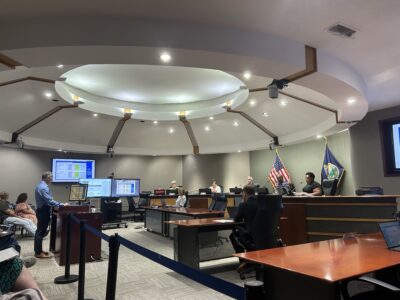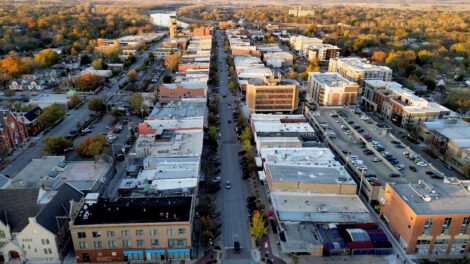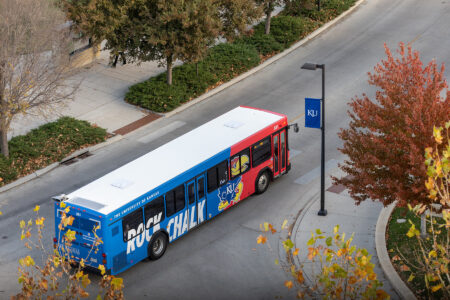In 2026 budget work session, Lawrence city commissioners and residents have questions on LDCFM cuts, funding for bike and pedestrian projects

photo by: Bremen Keasey
Lawrence City Manager Craig Owens provided an opening statement to City Commissioners about the city's 2026 budget proposal on Tuesday night.
During an initial work session on the proposed 2026 budget on Tuesday, Lawrence city commissioners and members of the public had questions about cuts to the fire and medical department, and some commenters asked for certain bike and pedestrian projects to be funded next year.
The initial budget proposal from City Manager Craig Owens, which was made public Thursday, featured a flat mill levy, cuts of $6.4 million across the city’s departments and the addition of $2 million to the city’s reserve fund. Those initial details reflected budget updates that were presented in April, and Owens told the commission the budget process had started “nine months earlier” than normal in an attempt to remedy a financial situation that was deemed unsustainable.
Owens said staff knew that situation would be “challenging to correct.” He said it required finding a good balance to cover a projected $6.5 million budget shortfall while still delivering key services. This year’s $431 million budget across all funds is down from last year’s $518.7 million budget, but Owens said the proposal in front of commissioners is a “sustainable plan.”
“(This proposal) is a healthy reality to achieve a sustainable budget for our community,” Owens said.
Alley Porter, a budget manager with the city finance department, presented commissioners with an outline of the general fund budget, which is the primary operating fund supported by property and sales tax. The 2026 proposal totaled $116.7 million and included $6.4 million in total cuts across several departments:
• $78,000 from the City Attorney’s Office, roughly a 4% cut
• $176,000 from the Economic Development Department, roughly a 13% cut
• $170,000 from the Homeless Solutions Department, roughly a 6% cut
• $1.5 million from Lawrence-Douglas County Fire Medical, roughly a 4% cut
• $1.1 million from the Municipal Services and Operations Department, roughly a 6% cut
• $1.3 million from the Lawrence Police Department, roughly a 4% cut
• $138,000 from the Planning and Development Services Department, roughly a 2% cut
• $1.8 million from the Parks, Recreation and Culture Department, roughly a 10% cut
Porter said despite the cuts — which Owens previously noted were about 5% of the city’s general fund budget — all the reductions in staffing across these departments only affect vacant positions. The city began offering voluntary early retirement packages and adopted an internal hiring policy to limit potential layoffs. Porter said that without the early start to the budget process, it wouldn’t have been possible to eliminate only vacant positions.
City department heads provided additional details to commissioners about how their departments would be affected. Joe Hardy, the acting chief of Lawrence-Douglas County Fire Medical, said the biggest priority for the department was maintaining four-person staffing on each fire truck, a key issue from last year’s budget discussions.
Hardy noted this proposal includes both expansion and reduction, making it challenging to balance. The city’s Capital Improvement Plan, a sort of blueprint for community infrastructure projects, would allocate funding to construct a new fire station, known as “Station 6.” But the budget proposal would also remove one fire engine out of the fleet, reducing the department’s daily minimum staffing from 39 people to 36 people.
Several firefighters spoke against that idea during the meeting’s public comment period. While Seamus Albritton, the president of the union that represents Lawrence firefighters, said that he was thankful that four-person staffing was a priority, he encouraged the commission to reconsider removing a fire truck from the rotation. Simon Stephenson, the secretary of the union, said that emergency calls had been increasing while the city was talking about shrinking the department.
Hardy said this proposal “has the least impact” in terms of reducing service levels while maintaining four-person staffing on trucks. Hardy also voiced support for the new station, but said there was a need for future discussions — including with Douglas County, which provides part of the funding for the department — on how to pay for that station’s staffing in the future.
Vice Mayor Brad Finkeldei asked Hardy about discussions with Douglas County officials on increasing ambulance fees. LDCFM presented those options during a meeting in June, as the Journal-World reported, and Finkeldei wanted to know the status of those discussions and where the money generated might be allocated. Hardy said that the discussions are ongoing, but that the proposal is something LDCFM supports as a way to find additional funding as EMS calls are increasing.
“We are committed to work together for smart, safe and sustainable solutions,” Hardy said.
A couple of dozen public commenters shared feedback about the budget. Some expressed concern about the transparency of the budget process and worries about debt funding. Others shared support for specific projects in the CIP that were currently unfunded.
A few commenters wanted the city to include a proposal that would redesign Kentucky and Tennessee streets by removing one lane for vehicles and adding a buffered bike lane on each street. Commenter Samuel Carter said the roads have been identified as two of the most dangerous in the city and that the current design “encourage(s) people to speed.”
Other unfunded items that received attention included three projects that would be part of the Lawrence Loop, a planned network of 22 miles of paved walking and biking paths around the city. The current CIP lists the remaining three Loop segments as unfunded. The total cost of those projects would be around $19.5 million.
The city received 95 written public comments urging the commission to allocate funding for those projects, and many of those comments said the segment between Michigan Street and Sandra Shaw Park — estimated to cost around $1.4 million — received $564,000 in grant funding from the Kansas Department of Transportation back in 2021.
Finkeldei asked city staff whether the city would lose that grant funding and about the status of that segment. Jake Baldwin, an engineering program manager with the Municipal Services and Operations department, said property acquisition required to complete that portion “has not been successful.” Additionally, the KDOT funding was granted specifically for the proposed route of that segment, so if they were to try something else the city “would have to give the funding back,” Baldwin said.
City commissioners did not take action on the budget, but they gave feedback to staff about the initial presentation. Finkeldei felt the proposal is at “a great starting point,” but wanted the city staff to explore more options about potentially adding the Loop projects back in the CIP. Commissioners Lisa Larsen and Bart Littlejohn also wanted that topic to be explored further.
The commission will establish public hearings and the publication of the budget during its July 15 meeting. Formal adoption of the budget is scheduled to take place during its Sept. 16 meeting.







